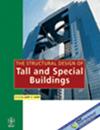Life‐cycle cost analysis and life‐cycle assessment of the second‐generation benchmark building subject to typhoon wind loads in Hong Kong
IF 1.3
3区 工程技术
Q3 CONSTRUCTION & BUILDING TECHNOLOGY
引用次数: 0
Abstract
Tall buildings located in Hong Kong can suffer great damage caused by typhoon hazards throughout their lifetimes. In addition, the effect of wind hazards may be exacerbated due to increases in the typhoon intensity and frequency caused by the climate change effect. Therefore, developing a framework to evaluate and quantify the damage caused by wind hazards on tall buildings from the economic perspective is critical for engineers and building owners in designing a cost‐effective tall building. In this study, an economic damage indicator, life‐cycle cost, is measured by using a probabilistic method called life‐cycle cost analysis (LCCA). Moreover, the building sector is one of the biggest contributors to greenhouse gas (GHG) emissions, and the environmental impact that may be generated in intervention activities after wind‐induced damage occurs is analyzed. An environmental impact indicator, embodied carbon emission, is quantified by employing another probabilistic method called life‐cycle assessment (LCA). Therefore, an integrated methodology combining the LCCA and LCA is proposed to evaluate potential damage costs and environmental impact caused by typhoon hazards on tall buildings.香港第二代基准建筑物受台风风荷载影响的生命周期成本分析及生命周期评估
香港的高层建筑在其整个生命周期内都会受到台风灾害的严重破坏。此外,由于气候变化效应导致的台风强度和频率的增加,风害的影响可能会加剧。因此,开发一个框架,从经济角度评估和量化风对高层建筑造成的损害,对于工程师和建筑业主在设计具有成本效益的高层建筑时至关重要。在本研究中,使用一种称为生命周期成本分析(LCCA)的概率方法来测量经济损失指标——生命周期成本。此外,建筑部门是温室气体(GHG)排放的最大贡献者之一,并分析了在风引起的损害发生后,在干预活动中可能产生的环境影响。环境影响指标隐含碳排放通过采用另一种称为生命周期评估(LCA)的概率方法进行量化。因此,本文提出了一种结合LCCA和LCA的综合方法来评估台风灾害对高层建筑的潜在损害成本和环境影响。
本文章由计算机程序翻译,如有差异,请以英文原文为准。
求助全文
约1分钟内获得全文
求助全文
来源期刊
CiteScore
5.30
自引率
4.20%
发文量
83
审稿时长
6-12 weeks
期刊介绍:
The Structural Design of Tall and Special Buildings provides structural engineers and contractors with a detailed written presentation of innovative structural engineering and construction practices for tall and special buildings. It also presents applied research on new materials or analysis methods that can directly benefit structural engineers involved in the design of tall and special buildings. The editor''s policy is to maintain a reasonable balance between papers from design engineers and from research workers so that the Journal will be useful to both groups. The problems in this field and their solutions are international in character and require a knowledge of several traditional disciplines and the Journal will reflect this.
The main subject of the Journal is the structural design and construction of tall and special buildings. The basic definition of a tall building, in the context of the Journal audience, is a structure that is equal to or greater than 50 meters (165 feet) in height, or 14 stories or greater. A special building is one with unique architectural or structural characteristics.
However, manuscripts dealing with chimneys, water towers, silos, cooling towers, and pools will generally not be considered for review. The journal will present papers on new innovative structural systems, materials and methods of analysis.

 求助内容:
求助内容: 应助结果提醒方式:
应助结果提醒方式:


